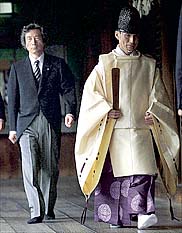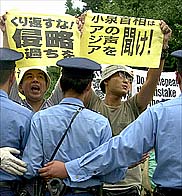

August 14, 2001
Japan's Premier Pleases Few With Visit to War Shrine
By STEPHANIE STROM
|
|
|
 OKYO, Aug. 13 — Prime Minister Junichiro Koizumi visited a shrine honoring the nation's war dead today, after yielding to international pressure and abandoning a plan to go on Wednesday, the anniversary of the Japanese surrender in World War II. His sudden change of plans, coming after weeks of debate about the issue, caught the police, the press and nearly everyone else by surprise. And it left Mr. Koizumi's critics somewhat deflated.
OKYO, Aug. 13 — Prime Minister Junichiro Koizumi visited a shrine honoring the nation's war dead today, after yielding to international pressure and abandoning a plan to go on Wednesday, the anniversary of the Japanese surrender in World War II. His sudden change of plans, coming after weeks of debate about the issue, caught the police, the press and nearly everyone else by surprise. And it left Mr. Koizumi's critics somewhat deflated.
But the visit to the Yasukuni shrine had already become a no-win situation for the prime minister. By going to the Shinto shrine on a day other than Aug. 15, he disappointed those who had been pressing him to demonstrate resolve by keeping the pledge he made when he became prime minister in April.
Nor were those who objected to his original plan mollified by his decision today. At the shrine this afternoon, two small bands of protesters, one representing Korean residents in Japan and the other a group of university students, criticized the decision to visit under any circumstances. Police cordons around the protesters outnumbered them 2 to 1.
The original plan to visit Yasukuni on Aug. 15, announced when Mr. Koizumi took office in April, raised the hackles of Japan's neighbors, particularly South Korea and China. Asian countries regard Yasukuni, which includes war criminals like the wartime prime minister, Hideki Tojo, among the 2.47 million Japanese soldiers honored there, as a symbol of Japanese militarism.
"It could be said that he gave consideration to the sentiment of Asian countries, including China and Korea, but because war criminals are enshrined there, I still object to the visit," said Yin Chiu Xiong, leader of the Tokyo Association of Chinese Residents. "It is a shrine devoted to maintaining Japanese national polity and to promote war, and therefore I oppose the visit by the prime minister and politicians."
The Chinese government issued a statement this evening condemning the prime minister's visit. The Korean Foreign Ministry also condemned the visit.
Given that his change in plan did not please the critics, "he might as well have visited on the 15th," said Yuko Tojo, granddaughter of the wartime prime minister. Ms. Tojo, whose grandfather was executed as a war criminal after the war, said she was disappointed that Mr. Koizumi had not stuck to his original plans. "He broke his promise, and young Japanese people won't trust him anymore," she said.
Even the duration of his visit became an issue. Mr. Koizumi spent all of 33 minutes at Yasukuni, from the time he stepped out of his car until he climbed back in, bowing only once to the 2.47 million war-dead-turned- gods who are honored there, and only briefly at that. Official Shinto practice calls for bowing twice, deeply, clapping twice and bowing again.
"I had hoped he would spend five or 10 minutes there and kneel down with his head deeply bowed and pray," said Koremaru Sakamoto, a professor of state Shinto at Kokugakuin University. "One minute is too short to pray for world peace and global restoration."
The shrine, near the Imperial Palace in Tokyo, was founded in 1869 and is a focal point of Japanese nationalism. It includes a 24-acre park with a bronze statue of Masujiro Omura, the 19th-century founder of Japan's modern army. The shrine itself is a simple wooden building. Record books there keep the names of the 2.46 million people — including the 2.3 million soldiers who died in World War II — who are honored there as gods. No one is buried there. A war museum, most of it devoted to World War II, is next to the shrine.
The last prime minister to visit Yasukuni while holding office was Ryutaro Hashimoto, who went five years ago on his birthday, July 29. The last prime minister to visit Yasukuni on Aug. 15 was Yasuhiro Nakasone, who declared his visit in 1985 to be "official."
In a statement read by Chief Cabinet Secretary Yasuo Fukuda shortly before Mr. Koizumi went to the shrine, the prime minister said he had changed his agenda in deference to national interests after listening to a wide range of domestic and international opposition to his plan.
The Japanese press reported that Mr. Koizumi had heard more than 100 people on the subject, and its pros and cons were widely and thoroughly discussed virtually since the day he became prime minister. "If my visit to the shrine on that day might make people in and out of the country suspicious about Japan's basic commitment to eliminate war and value peace, that is not what I wanted," he said in his statement. "I am ashamed that I had to retract what I said as prime minister, but right now I have to put aside my longtime beliefs and pursue my duty based on a wide range of national interests."
On Sunday he donated nearly $250 to the shrine for a wreath marked with his name and title. His spokesman said he had paid for the wreath with his own "pocket money." He also signed the visitors book "Prime Minister Junichiro Koizumi," but he refused to say whether he had made the visit in an official capacity or as a private citizen.
In trying to make his decision, Mr. Koizumi was torn between the outrage of neighbors who suffered from Japanese aggression and his own, perhaps more pressing, need to demonstrate resolve to his people, who are counting heavily on him to set Japan back on course after a decade of economic decline.
A survey conducted by the NTV television network showed that almost half of those polled supported the earlier decision to visit the shrine on the anniversary. He apparently decided in favor of international relations, though.
"I think it's unreasonable for other countries to try to intervene in what is a purely domestic matter," said Kiyoi Terui, 61, an office worker from Hiroshima Prefecture who happened to be strolling the grounds of the shrine this afternoon when Mr. Koizumi visited. "I myself suffered in air raids during the war, and I also have strong sympathy for those who fought in the war."
How much the change in plans will affect Mr. Koizumi domestically remains to be seen. More than 100 members of Parliament joined a group formed last week to put pressure on the prime minister to go to the shrine on Aug. 15. And many members of his own party pay homage at the shrine on that day.
"He has been labeled as a person who does whatever he says he will do, and now he's done something different from what he's been saying," said Shoichi Nakagawa, a member of Parliament from Mr. Koizumi's party, who started the pressure group. "I don't think it's going to be a plus for him."
Hiroshi Akiba, 38, an office worker who is a member of the People's Faction, a right-wing group, said he was disappointed with the prime minister's decision, even though he considered the day in 1952 when the American Army ended its occupation of Japan — April 28 in the United States and April 29 in Japan — to be the true end of the war. "I'd like to believe that he changed his mind out of consideration of foreign policy," said Mr. Akiba, who was at the shrine with three friends today. "But I think he just betrayed his own true feelings."

